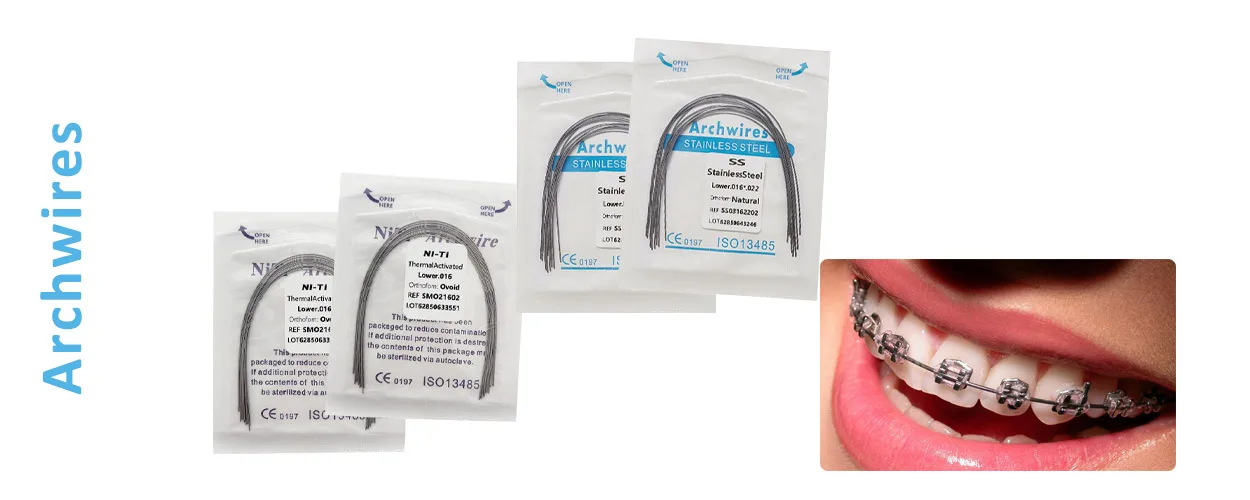In der kieferorthopädischen Behandlung, Archwire ist eine der Kernkomponenten des Halterungskorrektursystems. Wenn Sie Kieferorthopäde oder Zahnarzt für Zahnarztkäufe sind, Dieser Artikel wird die technischen Funktionen analysieren, Bewerbungsszenarien und Kaufvorschläge für kieferorthopädische Erzwire aus professioneller Sicht, Helfen Sie, Ihren klinischen Anforderungen effizienter zu entsprechen.
1. Was sind kieferorthopädische Erzwire?
Dünn, Flexible Metalldrähte, die an Zahnspangen befestigt werden, werden als kieferorthopädische Drahtbögen bezeichnet. Im Laufe der Zeit, Diese Drähte verschieben die Zähne durch Lichteinwirkung schrittweise in die richtige Position, Dauerdruck. Diese Drähte sind bekannt als “Bogendrähte,” und der untere Zahnbogen wird durch die Drähte an den unteren Zähnen gebildet, während der obere Zahnbogen durch die Drähte an den oberen Zähnen gebildet wird.
Sie wirken als Leitmotor für die Zähne und sind für die Steuerung der Zahnbewegung unerlässlich. Ohne es, Ihre krummen Zähne würden sich niemals bewegen. Diese Zahnspangenkabel sind in verschiedenen Größen erhältlich und haben unterschiedliche Materialzusammensetzungen.
2. Was ist die Funktion der Erzwire??
Als dynamisch-mechanische Komponente des kieferorthopädischen Systems, Die kieferorthopädischen Bögen ermöglichen eine passive Bewegung der Zähne durch einen präzisen Kompressionsmechanismus. Während der ersten Behandlungsphase, Kieferorthopäden wählen Bögen aus einer Nickel-Titan-Legierung mit geeignetem Elastizitätsmodul. Ihre Formgedächtniseigenschaften können eine kontinuierliche kieferorthopädische Kraft aufbringen 0.5 bis 1,5 N/cm² auf die Zahnfehlstellung. Diese mechanische Stimulation löst den Umbau des Alveolarknochens aus, indem sie die Proliferation von Osteoklasten auf der Druckseite und Osteoblasten auf der Spannungsseite aktiviert, Erzielung einer monatlichen Verdrängung von 0.1 bis 1mm für die Zähne.
Erzwire führen drei wesentliche Funktionen aus:
| Vektoranleitung | Feststellung der idealen Zahnbogenkrümmung durch vorgeformte Drahtformung |
| Kraftabgabe | Einschränkungen des Halterungssystemsystems in Richtzahnbewegungen übersetzen |
| 3D Kontrolle | Axiale Neigung und Rotationspositionierung durch Drehmomententwicklung einstellen |
Der dynamische Anpassungsmechanismus läuft über den gesamten Behandlungszyklus hinweg: Die Nachuntersuchung erfolgt jeden Tag 4 Zu 6 Wochen, und Kieferorthopäden sorgen für die optimale kieferorthopädische Kraft 20 auf 150 g/cm durch Austausch des Bogendrahts. Im mittleren und späteren Behandlungsstadium, Es geht in die Phase des Edelstahlbogens über (0.016×0,022 Zoll bis 0,019×0,025 Zoll), mit einem Elastizitätsmodul von 210GPa. Dies ermöglicht den Aufbau eines präzisen dreidimensionalen mechanischen Systems, Ermöglicht eine Feinregulierung der Wurzelspitzenbewegung und -okklusion.
Die dreistufige Theorie des Profits (Profitieren, Felder, & Sarver, 2018) Es folgt dieses biomechanische System: Erstausrichtung → Vertikalsteuerung → Drehmoment-Feinabstimmung, Dies führt zu einer 80–90-prozentigen Neupositionierung des Zahnbogens und einer funktionellen okklusalen Rekonstruktion. Nach klinischen Daten, Durch die standardisierte Anwendung des Bogensystems kann die Wurzelresorptionsrate unter dem sicheren Schwellenwert gehalten werden (< 2mm) und steigern Sie die Effizienz der kieferorthopädischen Behandlung 40%.
3. Die Wissenschaft hinter kieferorthopädischen Erzwirken
Der heutige Bogendraht ist ein Wunderwerk der Ingenieurskunst, im Gegensatz zur Kieferorthopädie’ homogener Ansatz im frühen 20. Jahrhundert. Der Schlüssel zu ihrem Erfolg liegt in der Materialwissenschaft: Die richtige Legierungsauswahl hat einen direkten Einfluss auf die Behandlungsgeschwindigkeit, Komfort, und Ergebnis.
Betrachten Sie NiTi (Nickel-Titan) Draht. Kaum jemand ahnte, dass NiTi ein zahnmedizinisches Potenzial haben würde, als Dr. William J.. Buehler bemerkte es zuerst “Formgedächtnis” Qualitäten im Naval Research Laboratory in den 1960er Jahren. Heutzutage, Diese Legierung ist eine wichtige Lösung für das Problem überfüllter Zähne, weil sie es kann “erinnern” Passt sich der idealen Zahnbogenform des Patienten an und hält dieser Belastung stand 8% Beanspruchung (wohingegen Stahl nur standhalten kann 1%).
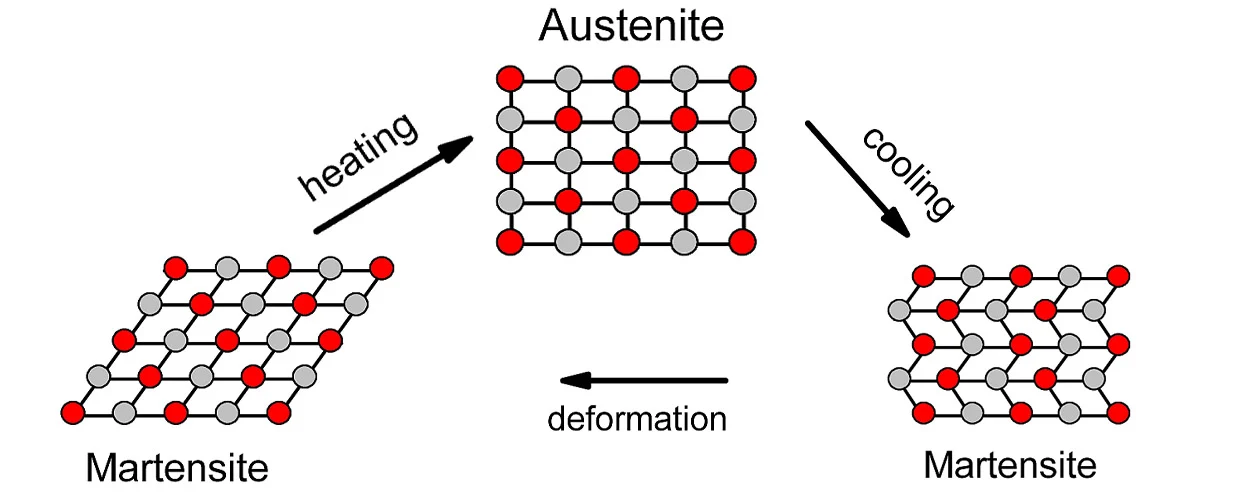
4. Klassifizierung der kieferorthopädischen Erzwire
Kieferorthopädische Bögen können aufgrund der unterschiedlichen Materialeigenschaften in drei Haupttypen eingeteilt werden:
A. Nickel-Titan-Erzwire (Niti)
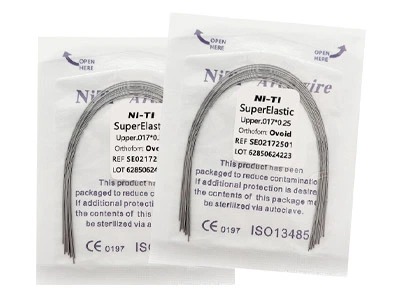
B. Edelstahl Erzwire
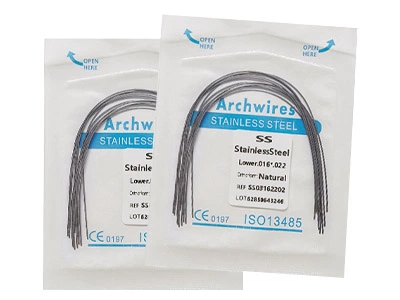
C. Beta-Titanium Erzwire
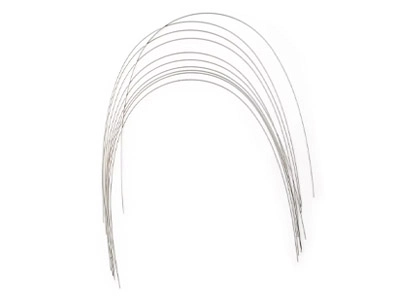
5. Klinische Auswahlkriterien für kieferorthopädische Erzwire
Passen Sie die Elastizität je nach Behandlungsstadium an die Festigkeit an
Zur Erstkorrektur, Superelastische Nickel-Titan-Bögen sollten Vorrang haben, um die Beschwerden des Patienten zu reduzieren. Im mittleren und späteren Stadium, Bogendrähte aus Edelstahl oder β-Titan werden ersetzt, um die Kraft präzise zu steuern.
Konzentrieren Sie sich auf den Oberflächenbehandlungsprozess
Hochwertige Bugdrähte sollten eine glatte Oberfläche haben (wie elektrochemisches Polieren) um die Reibung der Brackets zu verringern und Schleimhautreizungen zu vermeiden.
Standardisierte Abmessungen und Speicherleistung
Wählen Sie Bögen aus, die der AAO entsprechen (Amerikanische Kieferorthopädie-Vereinigung) Standards, um die Kompatibilität mit gängigen Bracketsystemen und eine hohe Formgedächtnisstabilität sicherzustellen.
6. Klinische Anwendungs- und Wartungsvorschläge
- Der Bogenaustauschzyklus: Die Zahnbewegungsgeschwindigkeit des Patienten und der Grad der Ermüdung kieferorthopädischer Bögen bestimmen, wie oft diese angepasst werden, Das ist normalerweise jeder 6 Zu 8 Wochen.
- Beratung für Patienten: Denken Sie daran, das Kauen harter Gegenstände zu unterlassen, Tragen Sie kieferorthopädisches Wachs auf, um anfängliche Beschwerden durch Reibung zu lindern, und reinigen Sie den Bogen regelmäßig, um Plaquebildung zu vermeiden.
- Speicheranforderungen: Um Oxidation oder Verformung zu verhindern, Ungeöffnete Bugdrähte sollten in einer trockenen Atmosphäre aufbewahrt werden.
7. Warum unsere wählen Kieferorthopäde?
Als Exporteur spezialisiert auf die Forschung und Entwicklung von zahnärztlichen Verbrauchsmaterialien für 15 Jahre, Wir bieten an:
Strenge Qualitätskontrolle: Produkte sind ISO 13485 zertifiziert, FDA/CE -konform und batch nachvollziehbar.
Diversifizierte Entscheidungen: Abdeckung des gesamten Größenbereichs von 0,012 ″ bis 0,021 × 0,025 ″, Unterstützung von Multimaterial-Anpassungen wie Nickel-Titanium, Edelstahl, Beta-Titanium und so weiter.
Fallfreigabe: Bogendrahtlösung zur Verbesserung der Effizienz der Klinik.
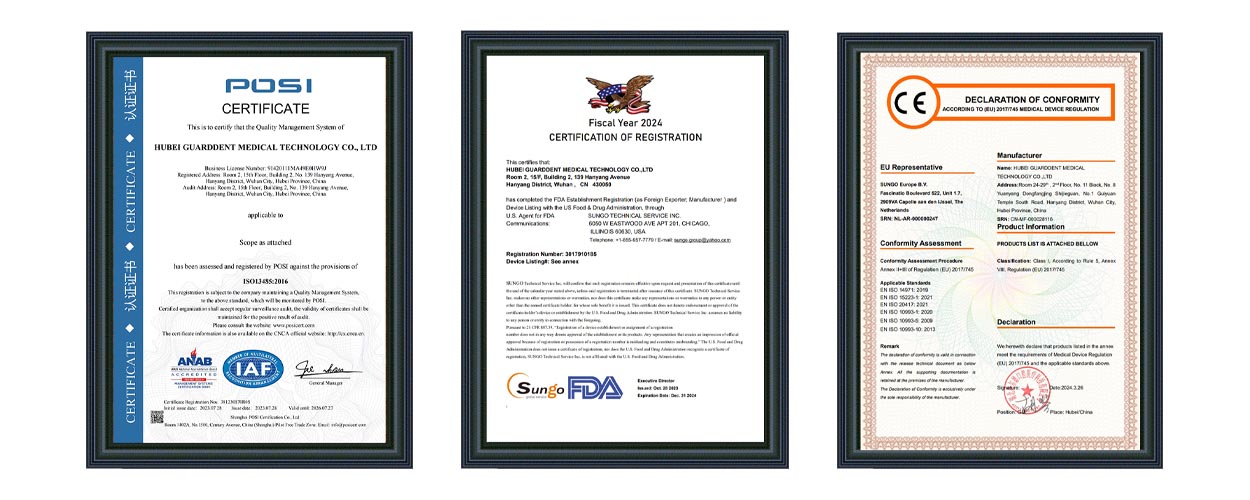
Eine Kette von Zahnkliniken in Barcelona, Spanien, reduzierte den durchschnittlichen Behandlungszyklus von Anfangsfällen durch 15% und die Zeit für Follow-up-Anpassungen von 20% Durch die Verwendung unserer Nitinolbogenwire. Das Feedback des Arzt, Das ist besonders für Patienten mit Teenagern geeignet. “
Abschluss
Trotz ihrer geringen Größe, Kieferorthopädische Bögen sind wesentliche Komponenten, die den Korrektureffekt beeinflussen. Die Auswahl des richtigen Bogendrahtes kann Patienten helfen’ Vertrauen in den Behandlungsverlauf und Erhöhung der Wirksamkeit von Diagnose und Behandlung. Bitte zögern Sie nicht, uns jederzeit zu kontaktieren, wenn Sie kostenlose Muster oder weitere Informationen zu unseren Produkten wünschen.
Referenzen
- Schah, S. J., Ali, M., & Matthews, M. E. (2015). Kieferorthopädische Materialien und Techniken. Zeitschrift für klinische Kieferorthopädie, 49(8), 23-34.
- Ribeiro, T. K. S. J., Silva, S. A. S., & da Silva, D. P. (2020). Biologische Mechanismen der Zahnbewegung: Eine Bewertung. Europäisches Journal für Kieferorthopädie, 42(2), 55-64.
- Profit, W. R., Felder, H. W., & Sarver, D. M. (2018). Zeitgenössische Kieferorthopädie (6th ed.). Elsevier.

